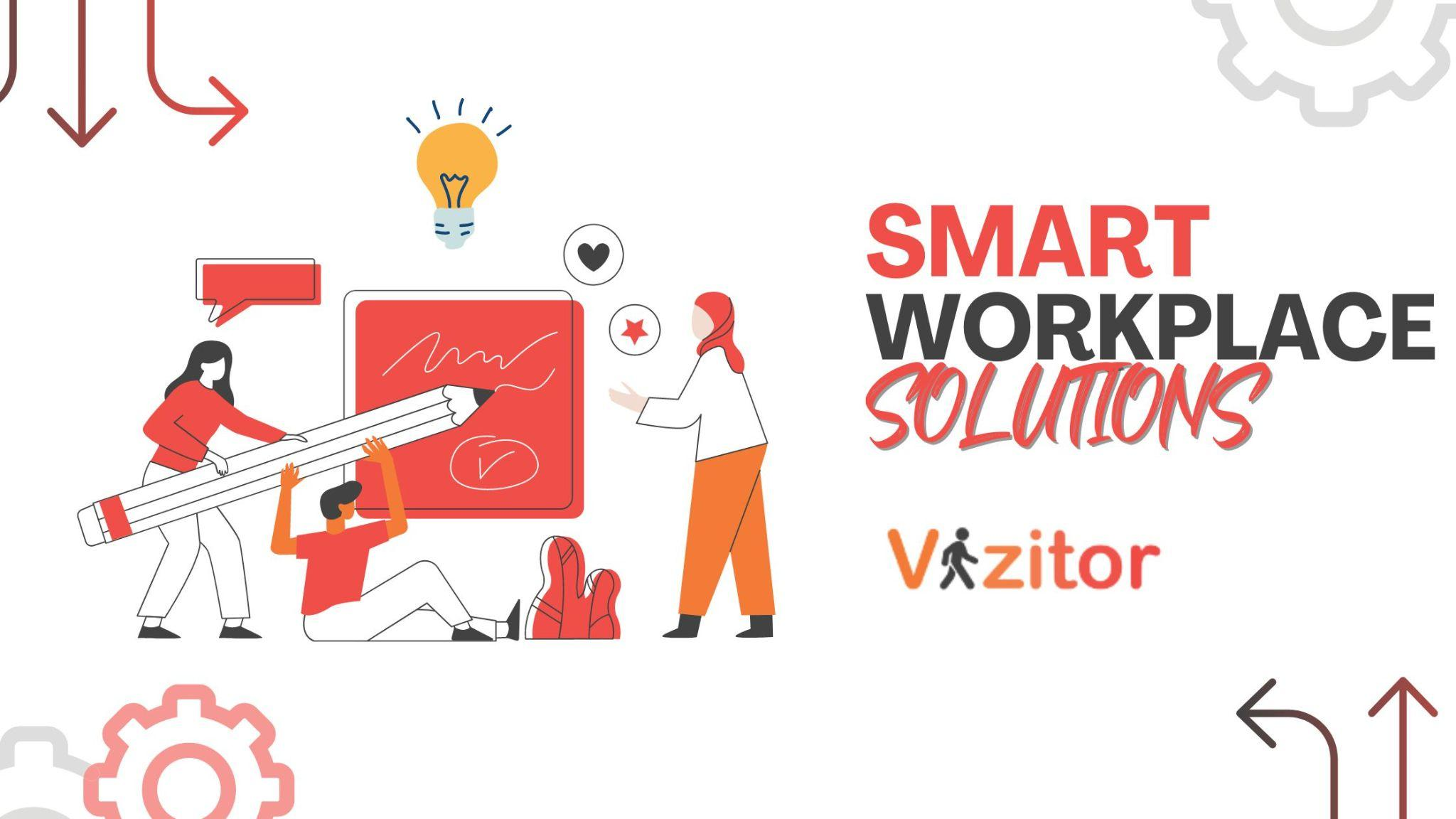Table of Content
Try Vizitor for Free!

Thu, May 23, 2024
Read in 6 minutes
The modern office has evolved dramatically in recent years. Did you know that smart workplace solutions can boost productivity by up to 30%? As businesses strive to create more efficient, productive, and enjoyable work environments, the adoption of smart technologies has become essential. This blog explores the essential tools and technologies that make a modern office smart and efficient.
These encompass a variety of technologies and tools designed to enhance the efficiency and functionality of office environments. These solutions are crucial for modern offices because they streamline operations, improve communication, and optimize resource management. The benefits of integrating these solutions include increased productivity, enhanced employee satisfaction, and better overall business performance.
Why Smart Workplace Solutions Are Evolving Rapidly?

The rapid evolution of these solutions is driven by the need for enhanced productivity, agility, cost-efficiency, employee satisfaction, and competitive advantage in today’s dynamic business landscape.
1. Technological Advancements
The continuous advancement of technology, especially in areas like IoT, AI, cloud computing, and data analytics, has enabled the development of sophisticated solutions. These technologies provide businesses with innovative tools to automate processes, improve decision-making, and enhance overall efficiency.
2. Remote Work Trend
The rise of remote and hybrid work models has accelerated the demand for smart office solutions. Organizations need tools and technologies that support seamless collaboration, communication, and productivity across distributed teams, regardless of location.
3. Employee Expectations
Modern employees expect a digital and tech-savvy work environment that enhances their experience and enables them to work efficiently. Smart workplace solutions cater to these expectations by offering user-friendly interfaces, mobile access, and personalized experiences.
4. Cost Savings
Smart office solutions often lead to cost savings in the long run. For example, energy-efficient systems, automated processes, and remote work capabilities can reduce operational expenses, improve resource utilization, and increase overall ROI.
5. Competitive Advantage
Businesses see smart office solutions as a competitive advantage. Adopting innovative technologies not only improves internal processes but also enhances customer service, fosters innovation, and positions companies as industry leaders.
6. Data-Driven Decision Making
Smart office solutions generate valuable data insights that empower organizations to make informed decisions. By leveraging data analytics and AI-driven analytics, businesses can optimize workflows, predict trends, and drive strategic initiatives.
7. Sustainability Initiatives
Many smart office solutions focus on sustainability and environmental conservation. Energy-efficient systems, paperless workflows, and remote work options contribute to reducing carbon footprints and aligning with corporate sustainability goals.
8. Regulatory Compliance
Compliance requirements and regulations, especially in areas like data privacy and security, drive the adoption of smart workplace solutions. These solutions often come with built-in security features and compliance measures to ensure data protection and regulatory adherence.
Essential Tools for a Smart Workplace

Essential tools for a smart workplace have emerged as indispensable assets, reshaping how organizations operate, collaborate, and innovate. From cutting-edge technology to ergonomic solutions, these tools are not just enhancing productivity but also fostering a dynamic work culture that prioritizes efficiency, flexibility, and employee well-being. Let’s delve into the world of essential tools for a smart workplace and uncover how they are revolutionizing modern office environments.
1. Smart Desks
Features: Adjustable height, integrated charging ports, ergonomic design.
Benefits: Smart desks promote better posture, increase comfort, and boost productivity. With the ability to adjust heights, employees can switch between sitting and standing, reducing the health risks associated with prolonged sitting.
2. Collaborative Software
• Examples: Slack, Microsoft Teams, Zoom.
• Benefits: Collaborative software enhances team communication, supports remote work, and streamlines project management. These tools allow for real-time communication, file sharing, and virtual meetings, making collaboration seamless and efficient.
3. Smart Lighting
• Features: Automated controls, energy efficiency, customizable lighting.
• Benefits: Smart lighting reduces energy costs, improves employee well-being, and enhances office ambiance. Automated controls can adjust lighting based on occupancy and natural light availability, creating a more comfortable working environment.
4. Automated Climate Control
• Features: Smart thermostats, zoned heating/cooling, remote control.
• Benefits: Automated climate control optimizes energy usage, maintains comfortable temperatures, and reduces utility costs. Smart thermostats can learn preferences and adjust settings automatically, ensuring a pleasant office environment.
Advanced Technologies for a Smart Office

As organizations embrace these advanced technologies, they are unlocking new levels of efficiency, productivity, and innovation, setting the stage for a truly intelligent and agile workplace. Let’s explore smart workplace technology for a smart office and discover how they are reshaping the future of work.
1. IoT Devices
• Examples: Smart sensors, connected appliances, security systems.
• Benefits: IoT devices enhance office security, improve maintenance, and provide data for better decision-making. For example, smart sensors can monitor air quality, occupancy, and energy usage, offering insights to optimize office operations.
2. AI and Machine Learning
• Applications: Predictive maintenance, virtual assistants, data analytics.
• Benefits: AI and machine learning increase efficiency, support data-driven decisions, and enhance user experience. Predictive maintenance can foresee equipment failures before they occur, reducing downtime and maintenance costs.
3. Cloud Computing
• Benefits: Cloud computing provides scalable storage solutions, supports remote access, and ensures data security. Employees can access files and applications from anywhere, promoting flexibility and collaboration.
4. Visitor Management Systems
• Features: Touchless check-in, digital logs, integrated security.
• Benefits: Visitor management systems improve visitor experience, enhance security, and streamline administrative tasks. Touchless check-in reduces physical contact, ensuring a safe and efficient entry process.
Implementation Strategies For A Smart Workplace
From initial assessment and meticulous planning to effective training and continuous monitoring, these strategies play a crucial role in maximizing the benefits of smart technologies. In this exploration of implementation strategies for a smart workplace, we delve into the key steps and best practices that organizations can follow to transform their work environments into efficient, productive, and innovative spaces.
1. Assessment
Evaluating current office needs and technology gaps is the first step in implementing smart workplace solutions. This involves analyzing existing workflows, identifying areas for improvement, and determining the technologies that can address these needs.
2. Planning
Developing a step-by-step plan for integrating smart tools is crucial for a smooth transition. This plan should include timelines, budget considerations, and a clear outline of the technologies to be adopted.
3. Training
Educating employees on how to use new technologies effectively is essential for maximizing their benefits. Training sessions, user manuals, and ongoing support can help employees adapt to new tools and integrate them into their daily routines.
4. Monitoring
Regularly reviewing and updating systems to ensure optimal performance is necessary for maintaining a smart workplace. Continuous monitoring allows for timely upgrades and adjustments, keeping the office environment efficient and up-to-date.
Vizitor - Your Smart Workplace Solution Provider
Vizitor is your comprehensive smart workplace solution provider, offering a range of innovative tools and technologies designed to streamline office operations, enhance security, and create a seamless workplace experience. With Vizitor, businesses can leverage cutting-edge visitor management systems, touchless check-in solutions, and digital logbooks to modernize their front desk processes and ensure a safe and efficient entry process for visitors.
Additionally, Vizitor’s integration capabilities with IoT devices, access control systems, and collaboration platforms enable organizations to create a truly connected and smart office environment. Whether it’s optimizing space management, improving employee productivity, or prioritizing data security, Vizitor provides the tools and expertise to transform your workplace into a smart and efficient hub of innovation.










